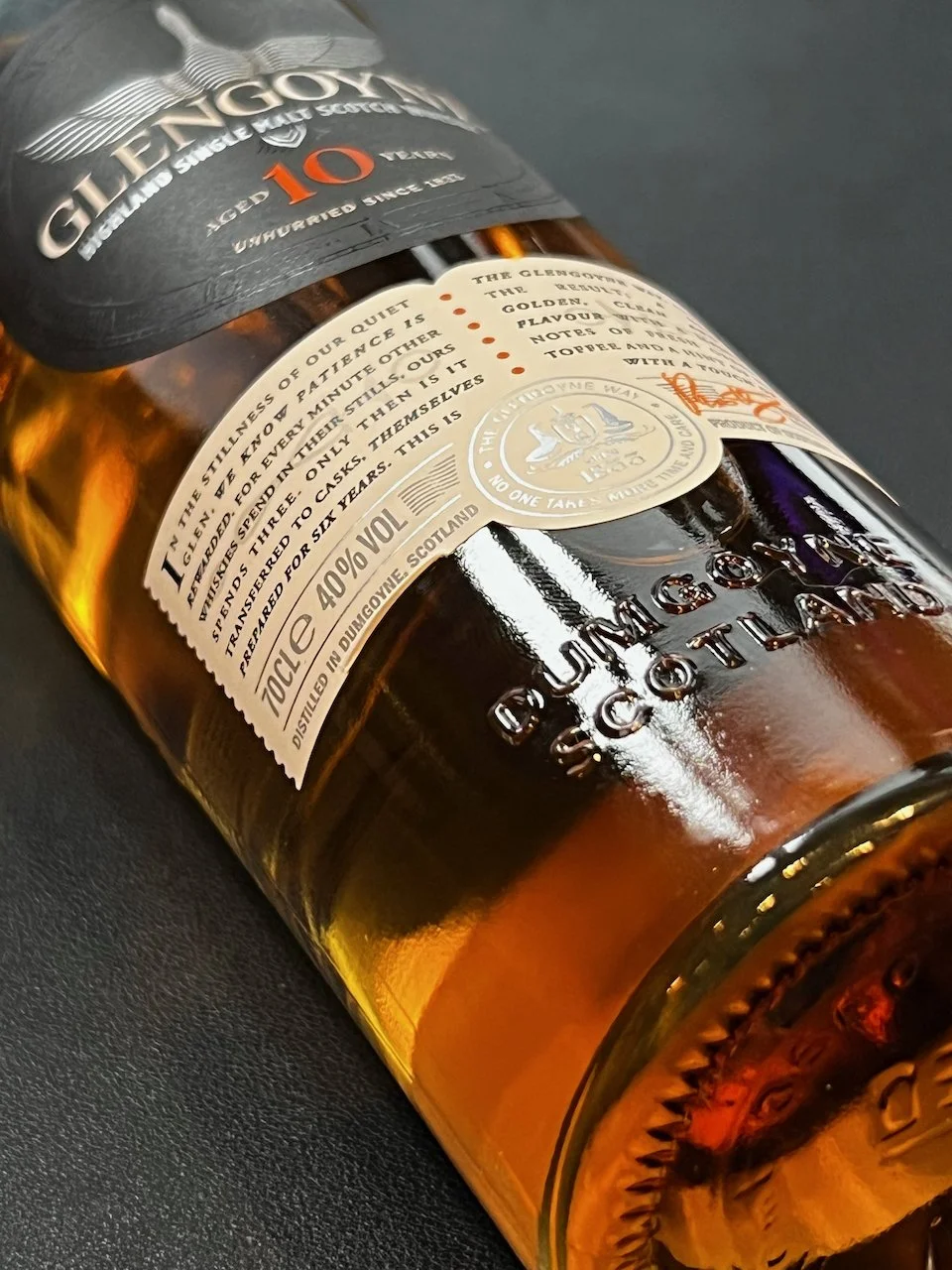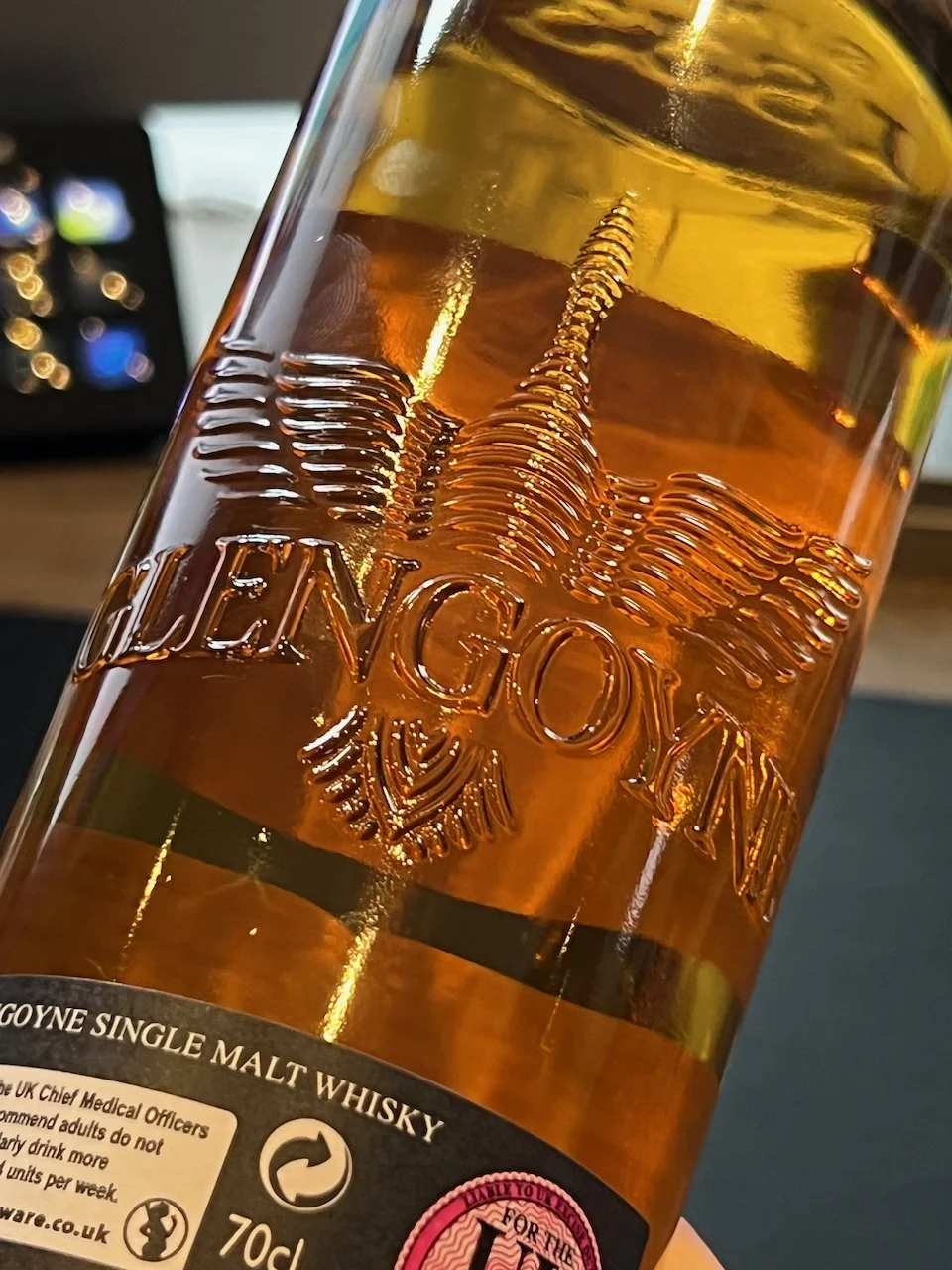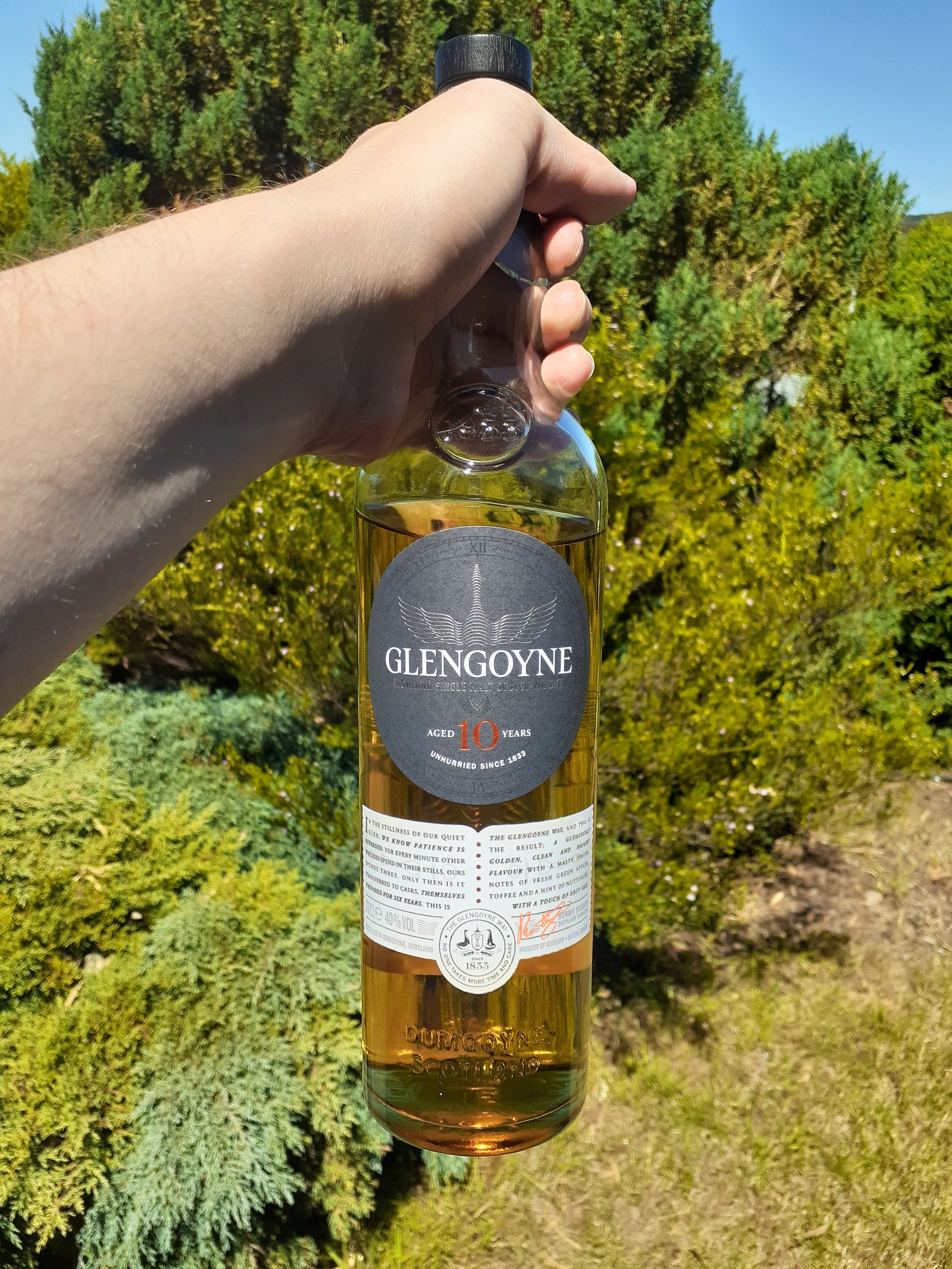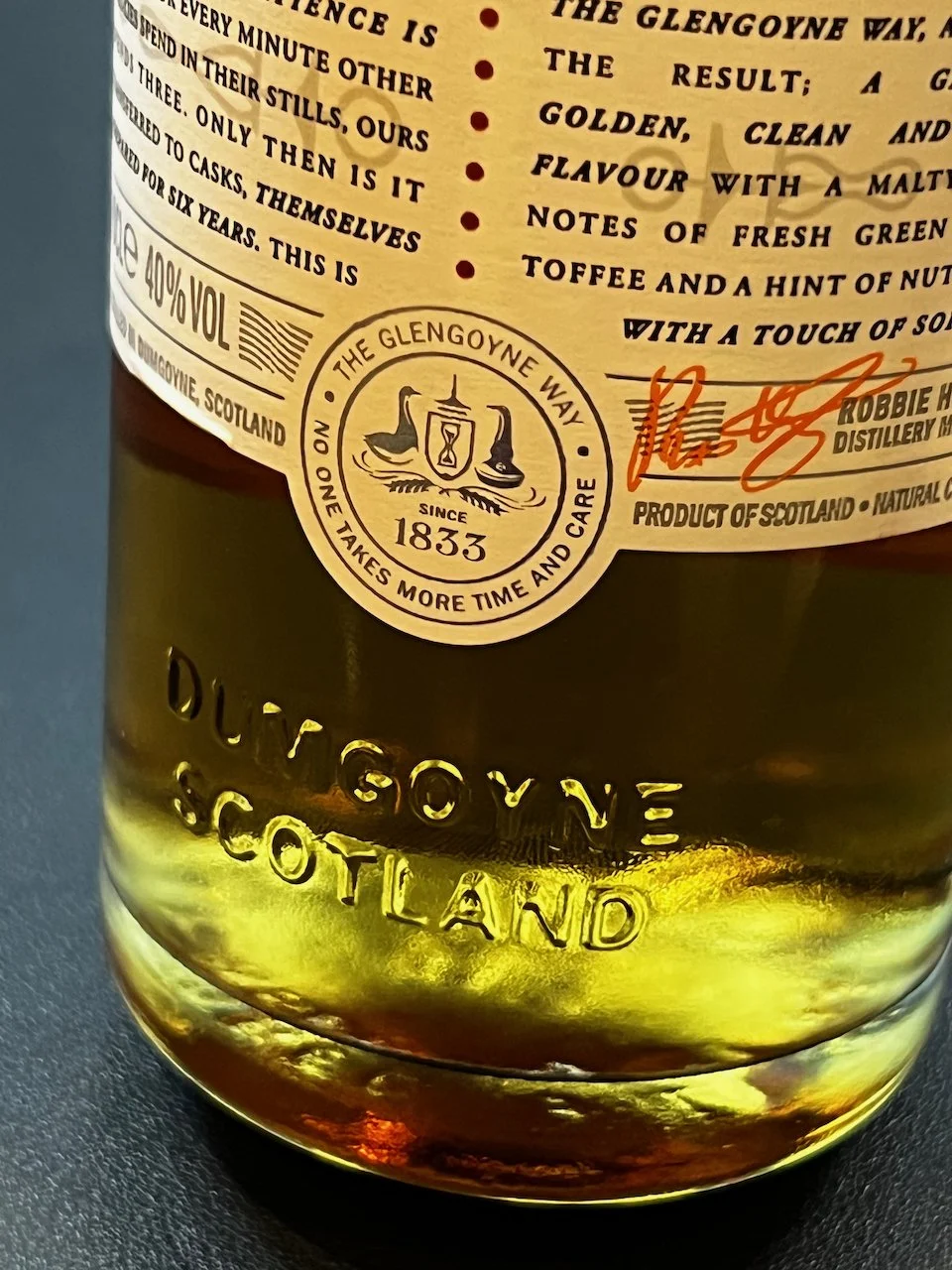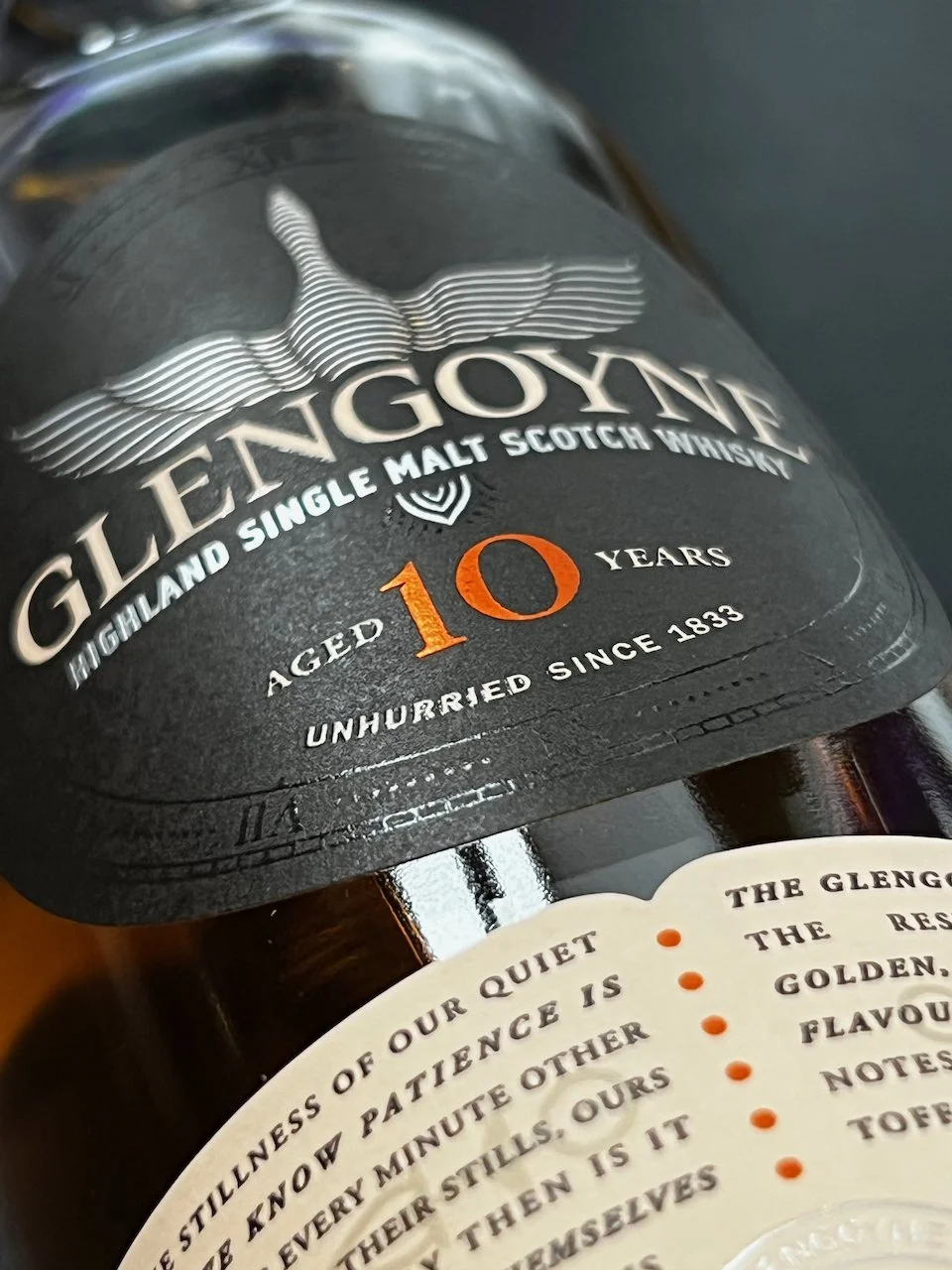Glengoyne 10yo
Official bottling | 40% ABV
Score: 3/10
Disappointing.
TL;DR
Some whisky just never clicks with us
No matter how hard I try…
…there are just certain whisky styles, distilleries and particular bottlings that just don’t work for me.
Some of those I’m quite grateful about- much of the overpriced Australian oak juice for one. Ridiculously marketed, elitist, anti-consumer interest modern Macallans for another. And as much as I don’t wish to go against the grain for the sake of contrarianism here, Glengoyne 10. I’ve tested my relationship with it, and thus far it’s proven repeatedly poor in my view. How is that you may ask?
I write a fair amount (by percentage at least) about the production methodologies of whisky, especially through the collective lenses of physics, maths, chemistry and biology, although at least half of these are completely amateur in approach. It might seem at a passing glance then that my main interests in whisky are the hows and cans, rather than the whys. This isn’t the case though, since my primary curiosity has always been and remains as flavour of whiskies and how organoleptics drives such. I’ll happily admit to being a nose-in-book analytic type though, and so wherever possible I like to gather data. Well, as I’ve expressed before, when it comes to organoleptics I think there is one ultimate, user-friendly and almost universally adaptable source of data to suit a slew of purposes; blind tasting.
Yes, since I was introduced to them via my first whisky club around the start time of the pandemic, blind tasting has been a fascination. I’ll admit initially it was motivated almost entirely by a slight competitive streak, but since then it has morphed into a tool to better understand the liquids before us, how they play to our noses and tongues as well as how they fare against one another. None of this is new information or contains new ideas, least of all to many of you dear learned readers, but please indulge me for a reminiscence or two. Chiefly, in my opinion, blind tasting operates in a near identical manner to the scientific method- we take our preconceived notions of a thing (the hypothesis) and test it without biases (ideally, if the system is well designed) so that either the testing data reinforces the hypothesis or forces us to redesign it.
Say for instance one posits that they can taste the difference between tawny port and ruby port casks within reasonable bounds of extraneous parameters- as long as one can design an adequate experiment for this (ie a flight of single malts with similar production specifications except the use of either a tawny or ruby port cask) then blind tasting allows one to interrogate that belief and gather data. It is, I believe, the single best way in which we can sharpen our tasting skills. If we don’t blind taste, we have no good idea of how our palates perform and thus also have little to no idea about how we taste whisky analytically. Since we can’t separate our sensory experience of reality from reality itself (Plato’s cave allegory), that’s as bad as knowing little to nothing about the whisky’s taste, particularly from an origin perspective.
As a digression, a consequence of this is that we have no way of absolutely confirming that what we taste elicits the same physical sensory response to other people given the same stimulus. The silver lining of course is that we have developed language to help us relate our experiences by using reference points for other things (as investigated more deeply in the recent Kilkerran article). As long as two people have an understanding of, for instance, what diacetyl smells like, they don’t need to physically sense the same thing when they smell it to use that as a descriptor for other smells.
Alas, the point stands- one ought to know themselves before others, and likewise know their own palate before making descriptive assertions.
“There is no bad whiskey. There are only some whiskeys that aren’t as good as others.”
So, in all fairness to the Glengoyne 10 I have almost identical issues with the 12YO and haven’t even been brave enough to venture to the rest of their core age statements as a result. I vaguely recall having tried one of their cask strength batches some time ago at a bar and not hating it, though quite a few drams, beers and chicken wings had already been consumed. Hence, I remain sceptical.
The first time I tried this distillery was just over a year ago. Having never been particularly advised by any trusted palates to sample from the distillery (except for the elusive teapot dram, which isn’t distributed to Australia) I hadn’t had much cause to gamble on the liquid- that is until one of my fellow Adelaidian malt fans, malt-maniac Craig Daniels invited me to a blind tasting event. Not just any club blind tasting event mind you, but the largest of its kind in Australia and one of the largest in the world; the Australian Malt Whisky Tasting Championships. To give an idea of the magnitude of this event, the legendary Michael Jackson even competed once- without any great success, mind you. Of course Michael may have been too busy drinking St. Magdalenes, Rosebanks and old Cragganmores to have any great familiarity with the cheap malts of the day.
The championships originated in Adelaide in 1989 from the labours of David Le Cornu et al, pioneering malt appreciators in the earliest days of whisky enthusiasm in Australia. David was also an early member of the infamous Gillies Club. If you’ve never heard of them I suggest you do some research, as it was these fine folks that played a most crucial role in the creation of the Black Bowmore bottlings- available to members at the time for a gut-wrenching $23AUD, which price adjusted for inflation equates to about $107AUD today. Yeah, I know. It’s OK to cry…
Anyway, I digress; the competition was run for a number of years in South Australia under the care of its founders, however the competition ceased after the owner sold the venue it was held in. After a number of years of intermission, the Scotch Malt Whisky Society brought the competition back on a national level and began to hold the competition in the Eastern States. Today the comp shares the same basic structure as it did back then, except that instead of evaluating twelve malts blind these days the task is to taste just eight malts from a line up of nine different potential options. This means that one of the potential malts is not on the table, and it is the tasters job to determine which of the nine that is, as well as the order of the eight that are present.
It used to be, once upon a time, that the organisers for the competition released a list of malts several months ahead of time from which the competition drams would be chosen- in the order of 30 if my memory serves. The idea for doing this was that the competition then became a strict meritocracy for those that had taken the time and effort to seek out and learn the profiles for those malts, committing them to memory.
Those with the best palates that could find distinguishing features for the malts had the best odds for performing well on the day. The result of this was plain- Craig Daniels, through his deserved moniker for maniacal malt aptitudes won the competition not once, nor twice or three times, but four times, as well as placing runner up three times. His record remains undefeated.
Of course this put a number of noses out of joint, and so the new organisers saw fit to increase the number of prospective malts to 50, as well as announcing the list a mere week from the competition date.
Regardless, when Craig asked if I was interested in joining him to train for the event, it was a no-brainer. Between Craig, myself and another regular Adelaide whisky socialiser we set to purchasing as many core range, widely available and cheap (the point had been made that the organisers generally favour the cheaper malts) whiskies as we could afford to set about our study. We each had our shopping lists, and though I didn’t know the regret it would cause, mine was the duty to purchase the Glengoyne.
Over the coming weeks and months, I would learn to recognise it in blind lineups not only for its particular features, but for my almost biological impulse to escape its smell and taste. It was instilled by Craig early on that if you could safely identify a whisky without tasting, that was all the better; save one’s palate for as long as possible, just in case one might need to compete in a tie-breaking taste off.
Glengoyne became such a malt for me- with regularity it stood out from its compatriots in a most unfortunate manner. In the year or so since training for that competition, I have had occasion to blind taste it four more times, both in club tastings and competitions. To the best of my memory, in every case I have correctly picked it out, usually without needing to taste it.
Shall we see exactly what my issue seems to be?
Review
Glengoyne 10yo, Official Bottling, 40% ABV (bottle code 10.21)
£33 - 34 & widely available, often on offer. £42.99 at the distillery. (AUD$80)
Nose
S.U.L.F.U.R. About as much of it as can be found without heavy sherry influence from obvious and tainted casks- not the worst, but not fun.
Struck match, vulcanised rubber, vegetable compost bin, a draff cereal note, new-make volatiles (touch of fly spray, mild vegemite autolysis tones) and mild vanilla. Goes on with some mild gas leak, a nose-feel like black pepper and hints of alliums.
Palate
Similar, thankfully the malt component lends a hand and some mild American oak (creamy vanilla, touch of caramel) helps soften the punches. There’s some added hints of roasted peanut skin and a few orchard fruits buried quite deep.
The Dregs
Basically I’ve learned this profile in blind tasting as “New make and sulfur with some malt”. Seems to have worked so far, even when one of those same components appears in other whiskies on a semi-blind match up list; it’s an unfortunately specific combination. The biggest saviour for this whisky is water, particularly on the nose. It brings some of the sweeter oak components out and hides a little of the noxious sulfur components.
Still, this is just a whisky that I never enjoy, whether with food, in blind tasting or even reviewing. I made myself try it again three times to write this, and that is three times too many. Add to my poor reception of its flavours the price increase it’s seen in recent times (I bought this bottle for about $60 AUD) and we have a cocktail of grievances. Speaking of which, that’s probably what the rest of this bottle will be used for- making cocktails. Either that or it’ll be redistilled in another experiment to gather more data about cuts and volatility points.
In any case, I can’t wait to hear the last glugs of this bottle and turn it into recycling. Allegedly blenders don’t mind some organosulfurs in their products as it tends to lend a roundness to the profile and fleshes out some of the thinner spots in the flavour profile, and I can see exactly how this style might fulfil that demand- as a single malt however, it is just not my cup of tea.
The perplexing thing to my mind is that Glengoyne advertise themselves as having one of the longest distillation times in Scotland, on top of which the new make strength indicates clean cuts, the condensers are copper shell and tube, fermentation times are moderate and the stills are equipped with moderate reflux bulbs- theoretically their new-make sulfur contribution should be fairly negligible. That said, there’s every chance their sherry cask suppliers are feeding them old era/heavily tainted casks which dramatically affect the whisky even with fairly light proportions of use.
Again, it’s important to stress here that this is just my palate, with my sensitivities and preferences- as always, one opinion shouldn’t dictate anyone’s purchases. I have pretty good evidence that my mercaptan tolerance is low, and this is clearly full of them, as the score reflects.
Score: 3/10*
*if you’re paying the full RRP - or the distillery price - of £43 this sails close to a 2/10. TK
Wally’s Review
Glengoyne 10yo, Official Bottling, 40% ABV (bottle code 09.22)
£33 - 34 & widely available, often on offer. £42.99 at the distillery. (£32.99 from Amazon)
Score: 4/10
Some promise.
TL;DR
An elegant Highlander, diluted.
Should I feel dirty paying £10 less for this from Starship Bezos than those who visited the hallowed ground at the foot of Dumgoyne hill?
I don’t.
I even had it delivered the same day, alongside some much needed groceries. I know there are tax and employment issues there, but damn they make it so easy. It hurts, but I’m weak. I’m not the government; allowing such convenience without consequence.
Anyway, to the liquid. Let me frame this by mentioning if there’s a whisky that I am in debt to, it’s arguable that this is it. It started everything for me; all the obsession, all the love, all the wonder, came from a single bottle of Glengoyne in 2005.
Back then, what I needed was something that tasted less like the harsh, acrid blast of pub-door breath and sweat and something that was much more welcoming, comforting and curious. For me, it just so happened to be a Glengoyne 10 year old. Sure, it was the sensory smash of Islay that had me realigning everything as, shortly afterwards, I fell down the whisky geek vortex, but I owe a lot to that wee distillery just north of home for initiating this whole journey.
I bought this 2022 bottle on the back of the write-up from Tyree above. The first bottle of Glengoyne I’ve bought in a long time. Why? Because I missed it? Maybe a desire to relive those first few sips? No. I felt a responsibility that, if there was to be such a low score served to that most elegant of Southern Highlanders, it won’t be without a sanity check from Wally.
So here I sit. Three nights on the bounce, with a 10 year old Glengoyne and thinking… Do I want to pour a second? I’m afraid the answer has been, three times on the bounce, no.
I do not get the repulsion that Tyree does. Not at all. I get a perfectly fine and pleasant, easy-but-forgettable, watered down to the point of sadness, malt whisky. I can’t go back to 2005, but if I could I can’t be sure this would be any different from what lit all of those early lights. I can, however, look at this from the perspective of a whisky nut, and in this light it is, in every way, perfectly fine. And utterly dull. All at once.
Nose
Perfumey and floral, with pear, a little lemon scent and sweet satsuma peel. A little new suede, malty porridge and sweet oak. Some fly spray, for sure. Damn you Tyree.
Palate
Grape juice, acidic at first, but honeys swing in to bring a little of that leathery-suede note, oak and malty sweetness. No sulphur, but I tend to be less susceptible to this trait in whisky. A hint of pepper , but the short finish leaves you with a sense of weak orange cordial. Overall, though, there’s a sense of death-by-dilution.
The Dregs
This whisky isn’t for Wally of 2022. It’s a product that’s designed, perhaps, for 2005 Wally. It was enough back then and, honestly, it seemed to do the trick. I need to concede that. Yet, I fear it’ll hang around here far too long.
Unlike Tyree, I don’t find faults, but I do find insipid. I find a malt that, while I know it to be capable of drawing tears of joy in other guises, I find it barely drawing flickers of interest. It’s an elegant malt but, stripped and diluted, it’s made to a price point. It is sacrificed. If you are reading this you are not Wally of 2005 and you are unlikely to be beguiled by this in any way.
So, while I will score this higher than my learned friend, don’t read that as a recommendation. Even at its discounted price there are alternatives that are far more flavourful and vibrant.
If you are upset at the score I share, I’ll draw your attention to the contrived £42.99 RRP. The one that you’re forced to pay at the distillery, and nowhere else. And at that price-point we’re spoiled for choice.
Score: 4/10 WMc
Tried this? Share your thoughts in the comments below. TK
-
Dramface is free.
Its fierce independence and community-focused content is funded by that same community. We don’t do ads, sponsorships or paid-for content. If you like what we do you can support us by becoming a Dramface member for the price of a magazine.
However, if you’ve found a particular article valuable, you also have the option to make a direct donation to the writer, here: buy me a dram - you’d make their day. Thank you.
For more on Dramface and our funding read our about page here.


